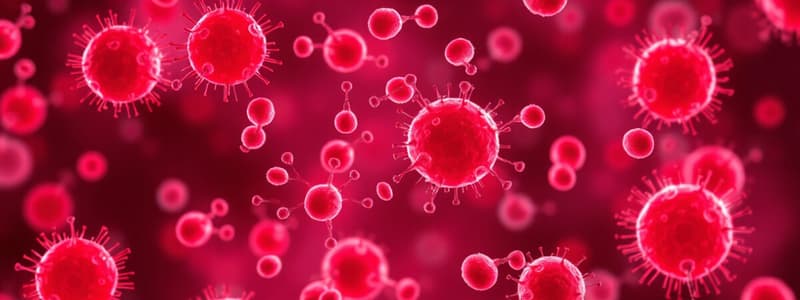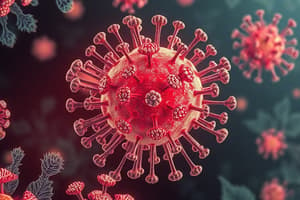Podcast
Questions and Answers
What is the primary characteristic of purulent inflammation?
What is the primary characteristic of purulent inflammation?
- Formation of blisters
- Accumulation of pus containing neutrophils (correct)
- Presence of fibrinous exudate
- Localized necrosis without fluid accumulation
What condition is most commonly associated with fibrinous inflammation?
What condition is most commonly associated with fibrinous inflammation?
- Acute appendicitis
- Peptic ulcer disease
- Meningitis (correct)
- Skin burns
Which statement about abscesses is correct?
Which statement about abscesses is correct?
- They are always associated with systemic leukopenia.
- They are confined to a space and consist primarily of serous fluid.
- They contain a central area of necrosis surrounded by neutrophils. (correct)
- They exhibit no inflammatory tissue response.
What defines serous inflammation?
What defines serous inflammation?
What is the main consequence of unresolved fibrinous inflammation?
What is the main consequence of unresolved fibrinous inflammation?
What is not one of the five cardinal signs of inflammation?
What is not one of the five cardinal signs of inflammation?
What term describes the process where leukocytes adhere to and align along blood vessel walls?
What term describes the process where leukocytes adhere to and align along blood vessel walls?
Which type of leukocyte is predominantly involved in acute inflammation?
Which type of leukocyte is predominantly involved in acute inflammation?
What is the main type of leukocyte involved in allergic reactions?
What is the main type of leukocyte involved in allergic reactions?
Which of the following best describes chemotaxis?
Which of the following best describes chemotaxis?
What allows leukocytes to assume a more peripheral position in blood flow?
What allows leukocytes to assume a more peripheral position in blood flow?
Which of the following is true about the infiltration of leukocytes?
Which of the following is true about the infiltration of leukocytes?
Which factor contributes to the chemotactic gradient for leukocytes?
Which factor contributes to the chemotactic gradient for leukocytes?
Flashcards
Cardinal Signs of Inflammation
Cardinal Signs of Inflammation
The five key characteristics of inflammation: redness (rubor), swelling (tumor), heat (calor), pain (dolor), and loss of function (functio laesa).
Leukocyte Adherence
Leukocyte Adherence
The process where white blood cells (leukocytes) stick to the inner lining of blood vessels (endothelium).
Margination
Margination
The process where leukocytes move to the periphery of blood vessels to prepare for adherence and extravasation.
Chemotaxis
Chemotaxis
Signup and view all the flashcards
Acute Inflammation
Acute Inflammation
Signup and view all the flashcards
Eosinophils
Eosinophils
Signup and view all the flashcards
Leukocyte Extravasation
Leukocyte Extravasation
Signup and view all the flashcards
Endothelium
Endothelium
Signup and view all the flashcards
Serous inflammation
Serous inflammation
Signup and view all the flashcards
Fibrinous inflammation
Fibrinous inflammation
Signup and view all the flashcards
Purulent/Suppurative inflammation
Purulent/Suppurative inflammation
Signup and view all the flashcards
Abscess
Abscess
Signup and view all the flashcards
Ulcer
Ulcer
Signup and view all the flashcards
Study Notes
Cardinal Signs of Inflammation
- Rubor: redness
- Tumor: swelling
- Calor: heat
- Dolor: pain
- Functio laesa: loss of function
Leukocyte Adherence to Endothelium
- Blood flow slows
- Wall shear stress decreases
- Leukocytes move to a more peripheral position
- Margination: neutrophils adhere to and align with vessels
- Rolling: cells bind and detach
- Adhesion: cells adhere via complimentary adhesion molecules
Chemotaxis
- Leukocytes cross the endothelium and basement membrane, entering extravascular tissue
- Cells follow a chemotactic gradient to reach the agent
Chemotaxis (Continued)
- Chemotaxis is the process of leukocytes leaving the circulatory system and moving toward tissue injury
- Bacterial products are chemotactic
- Endogenous chemotactic agents include cytokines
- The type of leukocytes that migrate depends on the stimulus and the inflammatory response's age
- Neutrophils dominate acute inflammation
Contrasting Inflammatory Responses
- Viral infections: lymphocytes are the initial responders
- Hypersensitivity reactions: lymphocytes and plasma cells are predominant
- Allergic reactions: eosinophils are the primary cell type
Bacterial vs. Viral Pneumonia
- Bacterial: Caused by streptococcus pneumonia; neutrophils and macrophages are the immune cells involved. Bacteria enter alveoli and multiply. Capillaries open allowing neutrophils to enter and fight the bacteria. Macrophages clean up debris.
- Viral: Caused by SARS-CoV-2 (COVID-19); lymphocytes are the principal immune cells. Viruses enter cells and replicate, leading to cell death. Lymphocytes recognize and destroy infected cells. Respiratory epithelial cells are replaced by type 2 pneumocytes.
Eosinophils
- Eosinophils are a type of white blood cell part of the innate immune response
- They defend against allergens, infections (like parasites), and autoimmune conditions
Acute Inflammation - Morphologic Patterns
- Serous inflammation
- Fibrinous inflammation
- Suppurative inflammation (purulent)
- Abscesses
- Ulcers
Serous Inflammation
- Characterized by cell-poor fluid accumulation in spaces
- Early stage of acute inflammation
- Examples include blisters from skin burns
Fibrinous Inflammation
- When vascular leaks are large, fibrinous exudate forms
- Examples include meningitis and pericarditis
- Fibrinous exudates are usually dissolved by macrophages
- Fibrosis occurs if exudates are not removed
Purulent Inflammation
- Characterized by pus (an exudate with neutrophils and necrotic debris)
- Purulent and suppurative inflammation are equivalent
- Bacteria are often the cause
- Acute appendicitis is an example
Abscesses
- Localized collections of purulent inflammatory tissue confined to a space
- Central portion exhibits necrosis
- Periphery contains preserved neutrophils and fibroblasts
Ulcers
- Local defects in organ or tissue surfaces
- Result from sloughing of necrotic, inflamed tissue
- Peptic ulcer disease is an example
Fate of Neutrophils
- Neutrophils undergo apoptosis (programmed cell death)
- They break down into smaller apoptotic bodies
Chronic Inflammation Morphologic Features
- Predominance of mononuclear cells (macrophages, lymphocytes, plasma cells)
- Lymphocytes (especially T cells) produce interferon gamma to activate macrophages
- Tissue destruction occurs
- Healing can involve fibrosis
Mast Cells
- Involved in allergic reactions, insect bites, and drug reactions
Studying That Suits You
Use AI to generate personalized quizzes and flashcards to suit your learning preferences.




